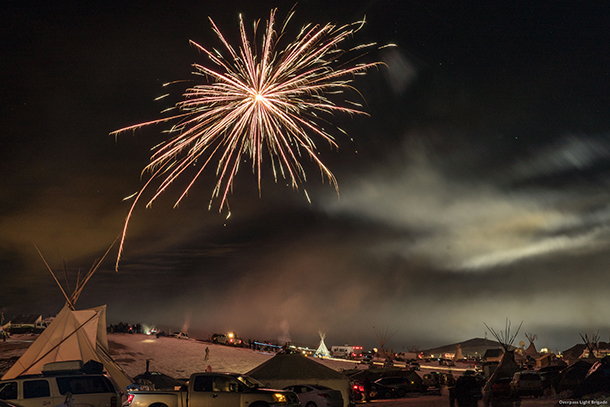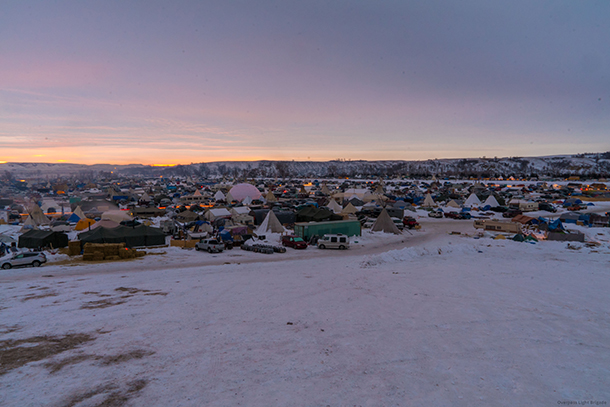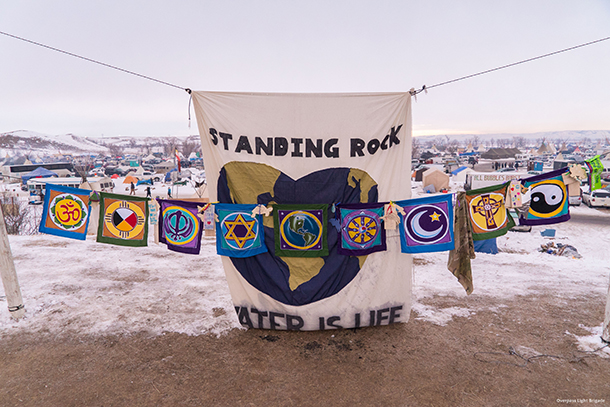Dakota Access Blocked
Air Date: Week of December 9, 2016

Celebratory fireworks light up the sky at the Sacred Stone camp on December 4th, following the Army Corps of Engineers’ announcement that it would not grant the Dakota Access pipeline an easement to drill under Lake Oahe. (Photo: Joe Brusky, Flickr CC BY-NC 2.0)
On December 4th, the Army Corps of Engineers announced that it would not grant the Dakota Access Pipeline an easement to drill under Lake Oahe without further review, and some are celebrating the decision as a victory for the Standing Rock Sioux tribe. Yet while the Corps has decided to do additional environmental review and look into alternative routes, the waters that the Standing Rock Sioux and their allies aim to protect might still be at risk. Host Steve Curwood spoke with Vermont Law School professor Pat Parenteau about how the Trump Administration might influence the pipeline’s progress.
Transcript
CURWOOD: From the Jennifer and Ted Stanley studios at the University of Massachusetts Boston and PRI, this is Living on Earth. I’m Steve Curwood. On December 4, opponents of the Dakota Access Pipeline in North Dakota won a significant battle, but it’s unclear if they have won their campaign to protect the waters and sacred grounds of the Standing Rock Sioux. The Obama Administration said it is not ready to grant an easement that the pipeline needs to pass under the Missouri River close by the reservation. And to underscore the concerns of the protestors who call themselves “water protectors,” on December 6, a state health official said a “significant” crude oil pipeline leak was found to have polluted a creek just 200 miles from where Standing Rock demonstrators have been camped. The incoming Trump administration has expressed support for Dakota Access, and to explain the legal options for both sides of the dispute we turn now to Vermont Law School professor Pat Parenteau. Pat, welcome back to Living on Earth.
PARENTEAU: Thank you, Steve.
CURWOOD: Pat, about this easement. It wasn't granted, and so people are celebrating. Well, they're celebrating cautiously. What does that mean from a legal perspective?
PARENTEAU: Well, what it means is, the corps is telling the pipeline company you do not have all the necessary approvals to complete the project and put the pipe under the Lake Oahe. We are going to engage in a longer review process, we're going to produce an environmental impact statement, we're going to consult further with the tribe, and we're going to look a lot harder at alternative routes for this that avoid the Lake Oahe crossing, and that's going to take a long time, many months, and the company of course is not very happy about that.
CURWOOD: So, to be clear here, the government hasn't really revoked anything here, it just hasn't issued the final order and says that there are other conditions that are necessary for the final order?
PARENTEAU: That's correct. The government takes the position that three approvals are needed. One of them is under the Clean Water Act and that's where the pipeline crosses a number of streams and wetlands. The second one is under the Rivers and Harbors Act. This is a very old 1899 statute that requires permission from the Corps of Engineers for use of federal property, and of course Lake Oahe is a federal reservoir. It was created by the Garrison dam authorized by Congress many years ago, so that's a separate authorization under the Rivers and Harbors Act, and then the third one which is the one that's now the focal point is under the Mineral Leasing Act, and this is a specific right-of-way for pipelines that cross federal land such as Lake Oahe.
CURWOOD: Pat, I understand on the heels of the administration saying, Nope, we're not cannot permit this thing at least at this time,” that the pipeline company went back in to court to push back. What did they do?

Snow now blankets the Sacred Stone camp where the Standing Rock Sioux and their allies have been camped since August, as the bleak North Dakota winter approaches. (Photo: Joe Brusky, Flickr CC BY-NC 2.0)
PARENTEAU: Yeah, the pipeline company is basically saying that the earlier approvals that the Corps of Engineers has given to the project and specifically to the crossing under Lake Oahe should be the final word on the right-of-way that they need and that the Corps has unlawfully changed its mind and now wants to revisit those earlier approvals under the guise of needing yet further approval under this Mineral Leasing Act requirement. And so the company is basically saying, “You gave us the green light before. Now under a lot of political pressure you want to backtrack on that, and that we don't think the court should allow you to do that. We want the court to order you to give us whatever final approval we need to complete this project. We've waited long enough.” So, that'll be an issue that the D.C. court is going to have to consider very quickly, probably within the next few weeks, and determine whether or not the company has a legitimate argument that the corps really shouldn't be able to reconsider decisions it's made before.
CURWOOD: And how can the Standing Rock Sioux folks push back on that demand?
PARENTEAU: The Standing Rock folks can also go to court and argue that the Corps of Engineers has made the correct decision, that it should engage in this full environmental review, and that, in the end, that review will show that this pipeline should not be placed under Lake Oahe but should be rerouted to avoid their water supply.
CURWOOD: What are the options, then, of the incoming Trump administration to speed up this process?
PARENTEAU: One thing the Trump administration could do would be to simply terminate the environmental review process and have the Corps of Engineers issue this final right-of-way and allow the project to be finished. Of course, that decision will be challenged by the tribe. There's a pending lawsuit in the United States District Court for the District of Columbia, and that case would be the forum for the tribes to challenge a Trump administration's order to simply issue the right-of-way and terminate the review process. The argument would be that's a purely arbitrary decision motivated by political motives -- a new administration, no new information, no changed circumstance, just simply a political decision to stop the process. And I believe the courts will look skeptically on a decision to simply terminate the environmental review process as opposed to let it run its course.
CURWOOD: So, one step at a time here then. How long would it take for this environmental review to take place? In other words, how soon might the Dakota Access pipeline people be able to continue this even with a favorable Trump agency behind this process for them?
PARENTEAU: My estimation is it would take 6 months to a year to do a full environmental impact statement, which requires, among other things, opportunity for public comment, opportunity for public meetings. Of course ever already been a number of these meetings and consultations, but this one is going to be much more focused on, for example, the original route for this pipeline was 10 miles north of Bismarck, and the corps has signaled it wants to take another look at that route and why that route was not selected by the company. And there are many other questions about pipeline safety and security. There's these questions about whether the tribe actually has some special treaty rights that were recognized in this old 1851 Treaty of Fort Laramie that deals with Lake Oahe. So that kind of a process is going to take months, and of course that would be litigation after all that is done as well. So, we're quite a long ways from a final decision, if the process is allowed to play out.

Flags hang in the style of Tibetan prayer flags at the Sacred Stone camp (Photo: Joe Brusky, Flickr CC BY-NC 2.0)
CURWOOD: Sounds like in any event that the folks who been out there demonstrating and protesting this won't have to sit out there through this winter, that the earliest that any movement might come on this would be when the weather perhaps is a bit warmer.
PARENTEAU: Oh, I think that's true and, in fact, the tribal chairman David Archambault II has encouraged people to leave the sort of frozen grounds of the camp that they've established, that it’s really not very safe. This is pretty harsh conditions up there, and he's telling people go home and get warm, and wait and see what happens, but I've also heard from protesters on site that they're not leaving, that they don't trust the government probably for good reason, given the history of the government's treatment of these native peoples up there. So I don't know whether they're going to stick it out through the winter or not. Sounds like at least a good portion of them will stay.
CURWOOD: So, if this decision stands that there’ll be this environmental impact review, and the route has to be moved, who pays?
PARENTEAU: Well, the promoters of the pipeline, I think it's called Energy Transfer Partners based in Dallas Texas, as I understand it. This is a private company and a privately funded project. I think there are 17 banks at least -- Citibank is a big one -- are the financing the project. This is a debt finance project because it's several billion dollars, almost $four billion as I understand it, but if it has to be rerouted at no doubt considerable cost, it would fall on the pipeline owners and the banks that they are relying on for financing to get it done.
CURWOOD: What recourse could they have against the government saying, “Hey, look, you guys said we could do this and now you can't. It's going to cost us a bundle of cash.”
PARENTEAU: If they are able to convince the court that this latest decision by the Corps of Engineers is actually illegal and that they're entitled to the right-of-way, that's probably the company's best bet for avoiding having to reroute the project. If the court upholds what the Corps of Engineers is doing and ultimately upholds a decision to require a rerouting, the company wouldn't have a leg to stand on to claim compensation for that. That would just be the consequence of the exercise of regulatory authority, but I also have to say it's hard to imagine, with the Trump administration in office, it's hard to imagine that the Corps of Engineers is in fact going to mandate that they change the route of this pipeline. We’ll have to wait and see, and I know the tribe is counting on maybe that being the outcome, but I think that's very much in doubt.
CURWOOD: By the way, what did you make of the veterans groups joining the demonstrations there at the very end?
PARENTEAU: I thought that was really a remarkable show of solidarity by people that you wouldn't normally think would be coming to the aid of protesters, but a really admirable, courageous thing to basically provide protection for the protesters and stand with them on...not necessarily maybe even agreeing with their position on the pipeline, but certainly saying, ‘We agree with your First Amendment right to do what you're doing, and we've sworn to defend the United States and the United States Constitution, and we're going to stand with you to make sure that your civil rights are protected in this process.’ Pretty admirable thing to see.

Pat Parenteau is an environmental law expert and a professor at the Vermont Law School. (Photo: Vermont Law School)
CURWOOD: When the authorities used a water cannon that freezing night, I was reminded of Bull Connor at the bridge in Selma using firehoses in the civil rights movement and that when the nation saw that it was a turning point in the Civil Rights movement. To what extent might this be a turning point in the rights of Native Americans?
PARENTEAU: Right, I had the same reaction watching the militarized force being brought to bear on these protesters and frankly the incredible contrast with what happened with the Bundy group that took over the Malheur your national wildlife refuge for 40 days and were acquitted of any charges whatsoever for those actions. So, on the one hand you have protesters actually taking over possession of a Federal refuge and doing damage, serious physical damage to the refuge, and on the other hand you have a group of mostly peaceful -- You can't say that it was 100 percent there are always some people in any crowd that are going to cause trouble perhaps -- but mostly peaceful protesters having dogs sicced on them, water cannons sicced on them, rubber bullets fired at them. Very, very severe police reaction to their protest, and I hope that people watching this would be concerned. Yes, you need to reestablish law and order, but on the other hand, if you can't create a safe space for people that are legitimately concerned about a project that poses at least risk to their water supply even if you can't prove beyond a doubt that it will damage the water supply -- We do that pipelines leak after all -- If people can't protest projects like that without being subjected to these extreme crowd control measures, that says something about the state of our democracy, I think, in the United States, and their at least should be serious consideration for how these kinds of protests are going to be handled because this isn't the end. Whether it's climate or whether it's Native American communities threatened by projects or whether it's Black Lives Matter threatened by extreme police force, we know that across the length and breadth of America, the tensions that are arising or not being handled I think in the way that we would like to see them handled, and so that's a much broader discussion to be having. But Standing Rock is a symptom, I think, of a deeper problem with the way democracy is working in the United States right now.
CURWOOD: Pat Parenteau is a law professor at Vermont Law School. Thanks so much for taking time today, Pat.
PARENTEAU: My pleasure, Steve.
Links
New York Times map of the Dakota Access Pipeline controversy
EarthJustice filed a lawsuit on behalf of the Standing Rock Sioux tribe
Belle Fourche Pipeline spill in western North Dakota on December 5, 2016
Living on Earth’s previous interview with Pat Parenteau on the Dakota Access Pipeline
Living on Earth wants to hear from you!
Living on Earth
62 Calef Highway, Suite 212
Lee, NH 03861
Telephone: 617-287-4121
E-mail: comments@loe.org
Newsletter [Click here]
Donate to Living on Earth!
Living on Earth is an independent media program and relies entirely on contributions from listeners and institutions supporting public service. Please donate now to preserve an independent environmental voice.
NewsletterLiving on Earth offers a weekly delivery of the show's rundown to your mailbox. Sign up for our newsletter today!
 Sailors For The Sea: Be the change you want to sea.
Sailors For The Sea: Be the change you want to sea.
 The Grantham Foundation for the Protection of the Environment: Committed to protecting and improving the health of the global environment.
The Grantham Foundation for the Protection of the Environment: Committed to protecting and improving the health of the global environment.
 Contribute to Living on Earth and receive, as our gift to you, an archival print of one of Mark Seth Lender's extraordinary wildlife photographs. Follow the link to see Mark's current collection of photographs.
Contribute to Living on Earth and receive, as our gift to you, an archival print of one of Mark Seth Lender's extraordinary wildlife photographs. Follow the link to see Mark's current collection of photographs.
 Buy a signed copy of Mark Seth Lender's book Smeagull the Seagull & support Living on Earth
Buy a signed copy of Mark Seth Lender's book Smeagull the Seagull & support Living on Earth

